Mikoyan MiG-29
| MiG-29 | |
|---|---|
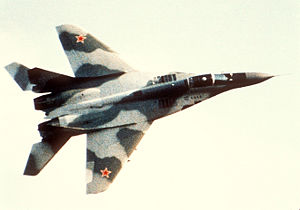 |
|
| Russian Air Force MiG-29. | |
| Role | Air-superiority fighter, multirole fighter |
| National origin | Soviet Union Russia |
| Manufacturer | Mikoyan |
| First flight | 6 October 1977 |
| Introduced | August 1983 |
| Status | Active service |
| Primary users | Russian Air Force Ukrainian Air Force Algerian Air Force Indian Air Force |
| Produced | 1982–present |
| Number built | 1,257+ |
| Variants | Mikoyan MiG-29M Mikoyan MiG-35 |
The Mikoyan MiG-29 (Russian: Микоян МиГ-29) is a 4th generation jet fighter aircraft designed for an air superiority role in the Soviet Union. Developed in the 1970s by the Mikoyan design bureau, it entered service with the Soviet Air Force in 1983, and remains in use by the Russian Air Force as well as in many other nations. NATO’s reporting name for the MiG-29 is "Fulcrum", which was unofficially used by Soviet pilots in service.[1] It was developed to counter new American fighters such as the F-16 Fighting Falcon, and the F-15 Eagle.
Contents |
Development
The history of the MiG-29, like that of the larger Sukhoi Su-27, started in 1969 when the Soviet Union learned of the U.S. Air Force’s "F-X" program, which resulted in the F-15 Eagle. The Soviet leadership soon realized that the new American fighter would represent a serious technological advantage over all existing Soviet fighters. The MiG-21 was agile by the standards of its day, but had deficiencies in range, armament, and growth potential. The MiG-23, developed to match the F-4 Phantom II, was fast and had more space for fuel and equipment, but lacked in maneuverability and dogfighting ability. What was needed was a better-balanced fighter with both good agility and sophisticated systems. In response, the Soviet General Staff issued a requirement for a Perspektivnyy Frontovoy Istrebitel (PFI, roughly "Advanced Frontline Fighter", literally "Perspective Frontline Fighter"). Specifications were extremely ambitious, calling for long range, good short-field performance (including the ability to use austere runways), excellent agility, Mach 2+ speed, and heavy armament. The aerodynamic design for the new aircraft was largely carried out by TsAGI in collaboration with the Sukhoi design bureau.

However, in 1971 the Soviets determined the PFI aircraft would be too expensive to procure in the quantities needed, and divided the requirement into the TPFI (Tyazhyolyy Perspektivnyy Frontovoy Istrebitel, "Heavy Advanced Tactical Fighter") and the LPFI (Lyogkiy Perspektivnyy Frontovoy Istrebitel, "Lightweight Advanced Tactical Fighter") programs, the latter paralleling the contemporary USAF decision that led to the "Lightweight Fighter" program and the F-16 Fighting Falcon and YF-17 Cobra. The heavy fighter remained with Sukhoi, resulting in the Sukhoi Su-27, while the lightweight fighter went to Mikoyan. Detailed design work on the resultant Product 9, designated MiG-29A, began in 1974, with the first flight taking place on 6 October 1977. The pre-production aircraft was first spotted by United States reconnaissance satellites in November of that year; it was dubbed Ram-L because it was observed at the Zhukovsky flight test center near the town of Ramenskoye. Early Western speculations suggested that the Ram-L was very similar in appearance to the YF-17 Cobra and powered by afterburning Tumansky R-25 turbojets.
Despite program delays caused by the loss of two prototypes in engine-related accidents, the MiG-29B production version entered service in August 1983 at the Kubinka air base. State acceptance trials were completed in 1984, and deliveries began the same year to the Soviet Frontal Aviation.
The workload split between TPFI and LPFI became more apparent as the MiG-29 filtered into front line service with the VVS in the mid-1980s. While the heavy, long range Su-27 was tasked with the more exotic and dangerous role of deep air-to-air sweeps of NATO high-value assets, the smaller MiG-29 directly replaced the MiG-23 in the frontal aviation role. The MiG-29 was positioned relatively close to the front lines, tasked with providing local air superiority to advancing Soviet motorized army units. Rugged landing gear and protective intake grates meant the MiG-29 could operate from the damaged or under-prepared airstrips Soviet war planners expected to encounter during a rapid armored advance. The MiG-29 was also tasked with escort duties for local strike and interdiction air packages, protecting vulnerable ground attack aircraft from NATO fighters such as the F-15 and F-16. Frontal aviation MiG-29s would ensure Soviet ground forces could operate under a safe air umbrella, moving forward with the troops as they advanced.
In the West, the new fighter was given the NATO reporting name "Fulcrum-A" because the pre-production MiG-29A, which should have logically received this designation, remained unknown in the West at that time. The MiG-29B was widely exported in downgraded versions known as MiG-29B 9-12A and MiG-29B 9-12B (for Warsaw Pact and non-Warsaw Pact nations, respectively), with less capable avionics and no capability for delivering nuclear weapons. Total production was about 840 aircraft.
Refined versions of the MiG-29 with improved avionics were fielded by the Soviet Union, but Mikoyan’s multi-role variants, including a carrier-based version designated MiG-29K, were never produced in large numbers. In the post-Soviet era, MiG-29 development was influenced by the Mikoyan bureau's apparent lack of political clout compared to rival Sukhoi. Some more advanced versions are still being pursued for export, and updates of existing Russian aircraft are likely. New versions of the plane called MiG-29SMT and MiG-29M1/M2 are being developed. Furthermore, development of a carrier version, the MiG-29K, has been resumed for the Indian Navy's INS Vikramaditya aircraft carrier (formerly the Russian aircraft carrier Admiral Gorshkov). This version was originally meant for Soviet service onboard the Admiral Kuznetsov, but the bigger Sukhoi Su-33 was preferred instead.
The Soviet Union did not assign official names to most of its aircraft, although nicknames were common. Unusually, some Soviet pilots found the MiG-29’s NATO reporting name, Fulcrum, to be a flattering description of the aircraft’s intended purpose, and it is sometimes unofficially used in Russian service.[1]
Design
Features

Because it was developed from the same basic parameters laid out by TsAGI for the original PFI, the MiG-29 is aerodynamically broadly similar to the Sukhoi Su-27, but with some notable differences. It is built largely out of aluminium with some composite materials. It has a mid-mounted swept wing with blended leading-edge root extensions (LERXs) swept at around 40°. There are swept tailplanes and two vertical fins, mounted on booms outboard of the engines. Automatic slats are mounted on the leading edges of the wings; they are four-segment on early models and five-segment on some later variants. On the trailing edge, there are maneuvering flaps and wingtip ailerons.
The MiG-29 has hydraulic controls and a SAU-451 three-axis autopilot but, unlike the Su-27, no fly-by-wire control system. Nonetheless, it is very agile, with excellent instantaneous and sustained turn performance, high alpha capability, and a general resistance to spins. The airframe is stressed for 9-g (88 m/s²) maneuvers. The controls have "soft" limiters to prevent the pilot from exceeding the g and alpha limits, but these can be disabled manually. In joint USAF-Luftwaffe exercises, the MiG-29 that the Luftwaffe fielded defeated the F-16 in close combat almost every time using its highly practical IRST sensor and helmet mounted display, together with the Vympel R-73 (NATO: AA-11 'Archer') missile.
Powerplant
The MiG-29 has two widely spaced Klimov RD-33 turbofan engines, each rated at 50.0 kN (11,240 lb) dry and 81.3 kN (18,277 lb) in afterburner. The space between the engines generates lift, thereby reducing effective wing loading, to improve maneuverability. The engines are fed through wedge-type intakes fitted under the LERXs, which have variable ramps to allow high-Mach speeds. As an adaptation to rough-field operations, main air inlet can be closed completely and alter using the auxiliary air inlet on the upper fuselage for takeoff, landing and low-altitude flying, preventing ingestion of ground debris (foreign object damage [FOD]). Thereby the engines receive air through louvers on the LERXs which open automatically when intakes are closed. However the latest variant of the family, the MiG-35, eliminated these dorsal louvers, and adopted the mesh screens design in the main intakes, similar to those fitted to the Su-27.[2]
Range and fuel system

The internal fuel capacity of the original MiG-29B is only 4,365 liters distributed between six fuel tanks, four in the fuselage and one in each wing. As a result, the aircraft has a very limited range, in line with the original Soviet requirements for a point-defense fighter. For longer flights, this can be supplemented by a 1,500 liter (330 Imp gal, 395 USgal) centerline drop tank and, on later production batches, two 1,150 liter ( 365 Imp gal, 300 USgal) underwing drop tanks. In addition, a small number have been fitted with port-side inflight refueling probes, allowing much longer flight times by using a probe-and-drogue system. Some MiG-29B airframes have been upgraded to the "Fatback" configuration (MiG-29 9-13), which adds a dorsal-mounted internal fuel tank. Advanced variants, such as the MiG-35, can be fitted with a conformal fuel tank on the dorsal spine, although none of them have yet entered service.
Cockpit

The pilot flies the aircraft with a conventional centre stick and left hand throttle. He is seated on a Zvezda K-36DM zero-zero ejection seat which has had impressive performance in emergency escapes.
The cockpit has conventional dials, with a head-up display (HUD) and a Shchel-3UM helmet mounted display, but no HOTAS ("hands-on-throttle-and-stick") capability. Emphasis seems to have been placed on making the cockpit similar to the earlier MiG-23 and other Soviet aircraft for ease of conversion, rather than on ergonomics. Nonetheless, the MiG-29 does have substantially better visibility than most previous Russian jet fighters, thanks to a high-mounted bubble canopy. Upgraded models introduce "glass cockpits" with modern liquid-crystal (LCD) multi-function displays (MFDs) and true HOTAS.
Sensors

The baseline MiG-29B has a Phazotron RLPK-29 (Radiolokatsyonnui Pritselnui Kompleks) radar Fire control system (FCS) which includes the N019 (Sapfir 29; NATO: 'Slot Back') look-down/shoot-down coherent pulse-Doppler radar and Ts100.02-02 digital computer. The original N-019A, which was supposed to put the MiG-29 on par with its Western counterparts, was a disappointment to VVS. It had serious shortcomings in beyond-visual-range (BVR) engagements. Tracking range against a fighter-sized target was only about 70 km (38 nm) in the frontal aspect and 35 km (19 nm) in the rear aspect. Range against bomber-sized targets was roughly double. Ten targets could be displayed in search mode, but the radar had to lock onto a single target for semi-active homing (SARH). The signal processor also had trouble with ground clutter, and ranges in the look-down mode were consequently further reduced. It was also quite susceptible to jamming. These problems meant the MiG-29 was not able to reliably utilize the new Vympel R-27R (NATO: AA-10 "Alamo") long-range SARH missile at its maximum ranges.

These performance deficiencies stemmed largely from the fact the N-019 radar was not, in fact, a new design. Instead, the system was a further development of the architecture already used in Phazotron's Sapfir-23ML system, then in use on the MiG-23ML. During the initial MiG-29 design specification period in the mid-1970s, Phazotron NIIR was tasked with producing a modern radar for the MiG-29. To speed development, Phazotron based its new design on the work undertaken by NPO Istok on the experimental "Soyuz" radar program. Accordingly, the N-019 was originally intended to have a flat planar array antenna and full digital signal processing, giving a detection and tracking range of at least 100km against a fighter-sized target. Given the state of Soviet avionics technology at the time, it was an ambitious goal. Testing and prototypes soon revealed this could not be attained in the required timeframe, at least not in a radar that would fit in the MiG-29's nose. Rather than design a completely new, albeit more modest radar, Phazotron reverted to a version of the twist cassegrain antenna used successfully on the Sapfir-23ML to save time and cost. This system used the same analog signal processors as their earlier designs, coupled with a NII Argon-designed Ts100 digital computer. While this decision provided a working radar system for the new fighter, it inherited all of the weak points of the earlier design. This reliance on 1960s-era technology continues to plague the MiG-29 in terms of its ability to detect and track airborne targets at ranges available with the R-27 and R-77 missiles, although new designs like the digital N-010 Zhuk-M address the serious signal processing shortcomings inherent in the analog design. Still, most MiG-29 aircraft in service continue to use the analog N-019 or N-019M radar, although VVS has indicated its desire to upgrade all existing MiG-29s to a fully digital system.
The N-019 was further compromised by Phazotron designer Adolf Tolkachev’s betrayal of the radar to the CIA, for which he was executed in 1986. In response to all of these problems, the Soviets hastily developed a modified N019M Topaz radar for the upgraded MiG-29S aircraft. However, VVS was reportedly still not satisfied with the performance of the system and demanded another upgrade. The latest upgraded aircraft offer the N-010 Zhuk-M), which has a planar array antenna rather than a dish, improving range, and a much superior processing ability, with multiple target engagement capability and compatibility with the Vympel R-77 (or RVV-AE) (NATO: AA-12 'Adder'). A useful feature the MiG-29 shares with the Su-27 is the S-31E2 KOLS, a combined laser rangefinder and IRST in an 'eyeball' mount forward of the cockpit canopy. This can be slaved to the radar or used independently, and provides exceptional gun-laying accuracy.
Armament
Armament for the MiG-29 includes a single GSh-30-1 30 mm cannon in the port wing root. This originally had a 150-round magazine, which was reduced to 100 rounds in later variants. Original production MiG-29B aircraft cannot fire the cannon when carrying a centerline fuel tank as it blocks the shell ejection port. This issue was corrected in the MiG-29S and later versions. Three pylons are provided under each wing (four in some variants), for a total of six (or eight). The inboard pylons can carry either a 1,150 liter (300 US gallon) fuel tank, one Vympel R-27 (AA-10 'Alamo') medium-range air-to-air missile, or unguided bombs or rockets. Some Soviet aircraft could carry a single nuclear bomb on the port inboard station. The outer pylons usually carry R-73 (AA-11 "Archer") dogfight missiles, although some users still retain the older R-60 (AA-8 "Aphid"). A single 1,500 liter (400 US gallon) tank can be fitted to the centerline, between the engines, for ferry flights, but this position is not used for combat stores. The original MiG-29B can carry general-purpose bombs and unguided rocket pods, but not precision-guided munitions. Upgraded models have provision for laser-guided and electro-optical bombs, as well as air-to-surface missiles.
Operational history

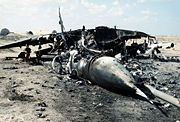
The MiG-29 was first publicly seen in the West during a visit to Finland in July 1986. Two were displayed at the Farnborough Airshow in Britain in September 1988. The following year, the aircraft conducted flying displays at the 1989 Paris Air Show where it was involved in a non-fatal crash during the first weekend of the show.[3] The Paris Air Show display was only the second display of Soviet fighters at an international air show since the 1930s. Western observers were impressed by its apparent capability and exceptional agility.
The Russian Air Force grounded all its MiG-29s following a crash in Siberia on 17 October, 2008.[4]
Combat action
The Soviet Union exported MiG-29s to several developing countries. Because 4th-generation fighter jets require the pilots to have extensive training, air-defense infrastructure, and constant maintenance and upgrade, MiG-29s have had mixed operational history with different air forces. For example, while the MiG-29s have an excellent operational history under the Indian Air Force which has invested heavily on the aircraft, it does not however have a good track record while serving the air forces of other countries like Iraq and Yugoslavia.
MiG-29s saw combat in the 1991 Gulf War at the hands of Iraqi pilots. According to the USAF, five MiG-29s were shot down, all by USAF F-15s.[5] Eight MiG-29 pilots managed to flee to Iran where their aircraft now serve in the Iranian Air Force, which now buys MiG-29s from Russia as well.
A Cuban MiG-29UB shot down two Cessna 337s belonging to the organization Brothers to the Rescue in 1996, after the planes approached Cuban airspace.[6]
According to some reports, in 1999 a few Eritrean MIG-29s were shot down by Ethiopian Su-27s piloted by Russian mercenaries. While there are some other reports of Eritrean MiG-29s shooting down two Ethiopian MiG-21s and three MiG-23s.[7]
On 20 April 2008, Georgian officials accused a Russian MiG-29 of shooting down a Georgian Hermes 450 unmanned aerial vehicle and provided video footage from the ill-fated drone showing an apparent MiG-29 launching an air-to-air missile at it. Russia denies that the aircraft was theirs and says they did not have any pilots in the air that day. Abkhazia’s separatist administration claimed its own forces shot down the drone with an L-39 aircraft "because it was violating Abkhaz airspace and breaching ceasefire agreements."[8] UN investigation concluded that the video was authentic and that the drone was shot down by a Russian MiG-29 or Su-27 using a R-73 heat seeking missile.[9] MiG-29s also performed close air support mission in the Russian invasion of Abkhaz and South Ossetia regions in the summer of 2008.
On 10 May 2008, the Darfur Justice and Equality Movement (JEM) troops mounted an assault on the Sudanese capital. During this action, a Sudanese Air Force MiG-29 was shot down by Darfur Justice and Equality Movement rebel forces with 12.7 mm and 14.5 mm heavy machine guns fire while it was attacking a convoy of vehicles in Khartoum suburb of Omdurman. The aircraft was piloted by a Russian mercenary. He was killed in action as his parachute did not open after ejecting. Regular Sudanese forces managed to repulse the attack and Sudan accused Chad of backing JEM in its attempt.[10] [11]
MiG-29 in Indian service
The Indian Air Force (IAF) placed an order for more than 50 MiG-29s in 1980 while the aircraft was still in its initial development phase. Since its induction into the IAF in 1985, the aircraft has undergone a series of modifications with the addition of new avionics, sub-systems, turbofan engines and radars.[12] The upgraded Indian version is known as Baaz (Hindi for Hawk) and forms a crucial component of the second-line offensive aircraft-fleet of the IAF after the Sukhoi Su-30MKI.
The MiG-29’s good operational record prompted India to sign a deal with Russia in 2005/06 to upgrade its 67 MiG-29s for US$888 million. Under the deal, Russia replaced the old N-019 radar with the Phazatron Zhuk-M radar. Russia also gave India’s Hindustan Aeronautics Limited the license to manufacture 120 RD-33 series 3 turbojet engines for the upgrade.[13] The MiG-29s were also upgraded for mid-air refueling to increase their endurance.[14] In 2008, the IAF awarded the MiG Corporation another US$900 million contract to upgrade all of its 69 operational MiG-29s. The upgrade will include a new weapon control system, avionics, cockpit ergonomics, air-to-air missiles, high-accuracy air-to-ground missiles and "smart" aerial bombs. The upgraded MiG-29s will also have an enhanced beyond-visual-range combat ability. The first six MiG-29s will be upgraded in Russia while the remaining 63 MiGs will be upgraded at the Hindustan Aeronautics facility in India. India also awarded a multi-million dollar contract to Israel Aircraft Industries to provide avionics and sub-systems for the upgrade.[15]
Kargil conflict
Indian MiG-29s saw action during the Kargil War in Kashmir in 1999. The IAF used the MiG-29s extensively for providing fighter escort for Mirage 2000s which were used for firing laser-guided bombs on enemy targets. According to Indian sources during the Kargil War, a pair of MiG-29s from IAF’s 47 (Black Archers) Squadron successfully locked onto two Pakistani Air Force (PAF) F-16s which were close to the Indian airspace. Since India and Pakistan were not officially at war during the time, the MiGs were ordered by the IAF command to give up the chase.[16] After this incident, the PAF ordered its aircraft to stay well within the Pakistani airspace. Also, during the conflict IAF Fulcrums were armed with RVV-AE missiles with BVR capability.
MiG-29 in Yugoslav and Serbian service

Socialist Federal Republic of Yugoslavia was the first European country to operate MiG-29. The SFR Yugoslav Air Force purchased a total of 14 MiG-29s and two MiG-29UBs from the USSR, in 1987. MiG-29s were taken into service with the 127 Lovacka Avijacijska Eskadrila (127. LAE, Fighter Aviation Squadron), known as Vitezovi (Knights), part of the 204. Lovacki Avijacijski Puk (204. LAP, Fighter Aviation Regiment) based at Batajnica Air Base, north of Belgrade, in what is today the Republic of Serbia. The aircraft was designated L-18 (L for Lovac, fighter), or NL-18 ('Nastavni Lovac, trainer fighter) for the "UB" version.
Serial numbers of MiG-29 fighters in YuAF:
- MiG-29: 18101-18114
- MiG-29UB: 18301-18302
A total of 16 aircraft remained, since SFR Yugoslavia was in process of developing its own supersonic fighter aircraft, designated Novi Avion. The Yugoslav MiG-29s saw little combat during the civil war in former Yugoslavia, and were used primarily for ground attacks. Several Antonov An-2 cargo aircraft used by Croatia were destroyed on the ground in Čepin airfield near Osijek, Croatia in 1991 by a MiG-29.
Whereas several MiG-21 aircraft were brought down by Croatian forces, no MiG-29s were lost during the civil war.[17]
NATO air war against FR Yugoslavia
The MiGs continued their service in the subsequent FRY Air Force and eventually in Serbian Air Force. During the long arms embargo placed upon the country, the condition of the MiGs worsened. Before operation Allied Force started, Yugoslav MiGs were over 10 years old, and deprived of spare parts. Some were totally "stripped" for their spare parts, to get other aircraft in operational condition. In March 1999, Yugoslav Air Force Command had 11 MiG-29 aircraft to pronounce operational.
A total of 6 MiG-29s were shot down of which 4 MiG-29 were shot down by USAF F-15C, 1 by USAF F-16CJ or friendly fire MANPADS and one by Dutch F-16AM.[18][19] Others were destroyed on the ground and one crash landed and later destroyed as it was placed as a decoy.[20] Two pilots killed (Maj.Zoran Radosavljević and Col.Milenko Pavlović) during the air war.
After the war
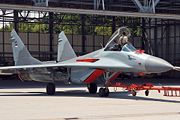
The unit continued flying its remaining five MiG-29s (at a very low rate) after the war, even if it had to replace the losses by MiG-21s evacuated from Pristina after the war. In spring 2004, however, news appeared that what was then the Air Force of Serbia and Montenegro ceased MiG-29 operations, because the aircraft could not be maintained.[17]
Currently, MiG-29s have resumed their service in the Serbian Air Force. In the 101.LAE (ex-127.LAE together with ex-126.LAE), part of the 204th Air Base, the first MiG-29 became operational by February 2008, a second one by March (UB version no.18301) and a third one by May. Another two will become operational by the summer of 2008, when their engines and components come back from overhaul in Russia. MiG-29 No.18101, which was overhauled first, was for the first time shown publicly on 15 February, the Military of Serbia Day and Statehood Day of the Republic of Serbia, during the military exercise "Sretenje 2008" in Niš. The aircraft was flown by Col Nebojša Đukanović, Chief of the Air Force and the Air Defense HQ.[21] The second MiG-29 that is back in service (MiG-29UB No.18301) is used for the training of pilots of the 101. LAE who have not flown on MiG-29s since 2004.[22] Aircraft 18101, flown again by Gen Nebojša Đukanović appeared for first time with new low-visible camo and markings in "Čenej 2008" air show. The third and fourth overhauled aircraft (MiG-29s no.18105 and 18108), together with the first two, flew over Belgrade city centre on September 12th 2008.
MiG-29 in German service

The German Democratic Republic bought 24 MiG-29s (20 MiG-29As, four MiG-29UBs), which entered service in 1988–1989. After the fall of the Berlin Wall in November 1989 and reunification of Germany in October 1990, the MiG-29s and other planes of the Luftstreitkräfte der NVA were integrated into the Luftwaffe. After upgrades by DaimlerChrysler Aerospace (now EADS) for NATO compatibility, they were designated MiG-29G and MiG-29GT. In March 1991, one of the MiG-29s in German service was transferred to the USAF for evaluation, along with several Su-22s and MiG-23s.
The Federation of American Scientists claims the MiG-29 is superior to the F-15 and other US fighters in short aerial engagements because of the Helmet Mounted Weapons Sight (HMS) and better maneuverability.[23] This has been proven when MiG-29s of the German Luftwaffe participated in joint DACT exercises with U.S. fighters.[24][25] German pilots constantly won close-in dogfights. The HMS was a great part of the success, allowing the Germans to achieve a lock on any target the pilot could see within the missile field of view, including those almost 45 degrees off boresight.[26] In contrast, the U.S. aircraft were only able to lock onto targets in a narrow window directly in front of the aircraft’s nose. It was not until late 2003 that the USAF and US Navy achieved Initial Operational Capability of the Joint Helmet Mounted Cueing System.
Since 1993 the German MiGs were stationed with 1./JG73 "Steinhoff" in Laage near Rostock. During the service in the Luftwaffe one MiG-29 ("29+09") was destroyed during an accident on 25 June 1996 due to pilot error. By 2003, Luftwaffe pilots had flown over 30,000 hours in the MiG-29. In September 2003, 22 of the 23 remaining machines were sold to the Polish Air Force for the symbolic price of €1 per example.[27] The last planes were transferred in August 2004.[28]
The 23rd MiG-29 ("29+03") remained on display in Laage before being moved to the Luftwaffenmuseum der Bundeswehr in Berlin’s Gatow Airport in 2006.[29]
MiG-29 in Polish service

The first 12 MiG-29 (nine MiG-29As, three MiG-29UB) were delivered to Poland in 1989-1990. The aircraft were based at Mińsk Mazowiecki and used by the 1st Fighter Aviation Regiment, in 2001 reorganized as 1 Eskadra Lotnictwa Taktycznego, or 1st Tactical Squadron. In 1995 10 used examples were acquired from the Czech Republic (nine MiG-29As, one MiG-29UB). After the retirement of its MiG-21s and -23s in 2003, Poland was left for a time with only these 22 MiG-29s in the interceptor role.
In 2004 Poland received 22 ex-Luftwaffe MiG-29s. 14 of these were overhauled and taken into service, equipping the 41st TS and replacing its MiG-21s. At present Poland has 32 active MiG-29s (26 MiG-29As, six MiG-29UB) which will serve at least until 2012–5. They are currently stationed in the 1st Tactical Squadron (1. elt) at the 23rd Air Base near Mińsk Mazowiecki and the 41st Tactical Squadron (41. elt) at the 22nd Air Base near Malbork. As of 2008, Poland is the biggest NATO MiG-29 user. The possibility of modernising the planes to enable them to serve until 2020–5 is being contemplated, depending on whether cooperation with Mikoyan can be established.
From 2007, MiGs are supported by Block 52+ F-16s from 3rd TS (replacing MiG-21) and 6th TS (replacing Su-22), from 2008 F-16s will also be used in 10th TS (replacing MiG-21).
There have been unconfirmed reports that Poland had at one point leased a MiG-29 from their own inventory to Israel for evaluation and the aircraft has since been returned to Poland, as suggested by photographs of a MiG-29 in Israeli use.
MiG-29s in the United States
In 1997, the United States purchased 21 Moldovan aircraft for evaluation and analysis, under the Cooperative Threat Reduction accord. Fourteen were MiG-29Ss, which are equipped with an active radar jammer in its spine and is capable of being armed with nuclear weapons. Part of the United States’ motive to purchase these aircraft was to prevent them from being sold to "rogue states", especially Iran.[30] In late 1997, the MiGs were delivered to the National Air and Space Intelligence Center (NASIC) at Wright-Patterson Air Force Base near Dayton, Ohio. One former Moldovan MiG-29S is currently on display at the National Museum of the United States Air Force at Wright-Patterson, and one MiG-29UB is on display at the NASIC headquarters of the base. Many of the former Moldovan MiG-29s are believed to have been scrapped. One MiG-29 is on display at Nellis AFB, Nevada, in Soviet colors, while another of the former Moldavian aircraft is located on the base in its original camouflage. At NAS Fallon, one MiG-29 is on display. Another is on display at MacDill AFB, minus its canopy, while a third is at Goodfellow AFB, Texas.
A private collector, Don Kirlin, has two MiG-29s purchased from Kyrgyzstan. They are supposedly lacking the avionics package, due to State Department restrictions, and so a Western avionics system would need to be sourced. They are currently located at the Quincy Regional Airport in Quincy, Illinois. According to airport workers, Kirlin paid US$100,000 for both aircraft. However, these MiG-29s are currently not flight-worthy and need a complete refurbishment.[31]
Variants



- MiG-29 (Product 9.12)
- Initial production version; entered service in 1983. NATO reporting code is Fulcrum-A.
- MiG-29B-12 (Product 9.12A)
- Downgraded export version for non-Warsaw Pact nations. Lacked a nuclear weapon delivery system and possessed downgraded radar, ECM and IFF. NATO reporting code is Fulcrum-A.
- MiG-29UB-12 (Product 9.51)
- Twin seat training model. Lacks radar and GSh-30 cannon. NATO reporting code is Fulcrum-A.
- MiG-29S
- The MiG-29S is virtually identical in external appearance to older "Fatback" MiG-29B airframes. Differences start with the improvements in the flight control system. Four new computers provide better stability augmentation and controllability with an increase of 2° in angle of attack (AoA). Its improved mechanical-hydraulic flight control system allows for greater control surface deflections. The MiG-29S added a dorsal 'hump' to the upper fuselage (earning it the nickname "Fatback" in service) which was originally believed to be for additional fuel, but in fact, most of its volume is used for the new L-203BE Gardenyia-1 ECM system. Internal fuel is only slightly increased by 75 liters, making the aircraft's fuel fraction about 0.27, thus comparable to that of the F-16. It can also carry 1,150 liter (304 US gallon, 2,000 lb) drop tanks under each wing and the traditional centerline tank. Inboard underwing hardpoints are upgraded to allow for a tandem pylon arrangement for a larger payload of 4,000 kg (8,820 lb). Overall maximum gross weight has been raised to 20,000 kg (44,000 lb).
- In the MiG-29S, the GSh-30-1 cannon has had its expended round ejector port modified to allow for firing while the centerline tank is still attached. As with the MiG-29, there are six underwing hardpoints, but these can be expanded to eight. The MiG-29S improvement would also allow for new missiles like the R-27E (AA-10 "Alamo") which has 1.5 times the range of the basic model R-27 due to its larger rocket motor. These long-burn variants have previously been only found on the Su-27 Flanker. The new hardpoint configuration also adds the capability to mount the new R-77 (AA-12 "Adder") active-radar, long-range air-to-air missile.
- Initially, the avionics of the MiG-29S only added a new IRST sighting system combined with a better imbedded training system that allowed for IR and radar target simulation. However, the final MiG-29S improvement kit also provides for the Phazotron N-019M radar and more built-in test equipment (BITE) (especially for the radar) to reduce dependence on ground support equipment; MiG MAPO calls this model the MiG-29SD. Revised weapon system algorithms in the MiG-29S's software, combined with an increase in processing capacity, allows for the tracking of up to 10 targets and the simultaneous engagement of two with the R-77 missile.
- The MiG-29S also has a limited ground-attack capability with unguided munitions, but in order to transform the MiG-29 into a true multi-role fighter, MAPO designed the MiG-29SM variant with the improved avionics necessary to carry and employ precision-guided weapons. The "SE/SD/SM" improvements in the MiG-29S, combined with the development money made available for the naval MiG-29K, gave MAPO the incentive to forge ahead with the multirole MiG-29M "Super Fulcrum".
- Flight performance of the MiG-29S is but slightly reduced compared to the original MiG-29 due to the weight of the additional fuel and avionics. Only 48 MiG-29S airframes were produced for the Russian VVS before funding was cut. Of this number, it is unknown how many are the standard air-superiority "S" version and how many are the multi-role "SM" version. NATO reporting code is Fulcrum-C.
- MiG-29S-13 (Product 9.13)
- MiG-29 variant similar to the 9.12, but with an enlarged fuselage spine containing additional fuel and a Gardeniya active jammer. NATO reporting code is Fulcrum-C.
- MiG-29S-13 (Product 9.13S)
- Version with the same airframe as the 9.13, but with an increased external weapons load of 4,000 kg, and provision for two underwing fuel tanks. Radar upgraded to N019ME, providing an ability to track 10 targets and engage 2 simultaneously. Compatible with the Vympel R-77 (AA-12 "Adder") air-to-air missile (similar to the AIM-120 AMRAAM). NATO reporting code is Fulcrum-C
- MiG-29SM (Product 9.13M_
- Similar to the 9.13, but with the ability to carry guided air-to-surface missiles and TV- and laser-guided bombs. NATO reporting code is Fulcrum-C.
- MiG-29K (Product 9.31)
- Naval variant, the latter "K" stands for "Korabelnogo bazirovaniya" (Deck-based ), with equipment such as folding wings, arrestor gear, and reinforced landing gear. Originally intended for the Admiral Kuznetsov class aircraft carriers, had even received series production approval from Russian Ministry of Defence but was later grounded in 1992 due to shift in military doctrine and state financial difficulty.[32] MiG Corporation restarted the program in 1999 and made vital improvement to the previous design. On 20 January 2004, Indian Navy signed a contract of 12 single-seat MiG-29K and four two-seat MiG-29KUB set delivery in the period from 2007 to 2009.[32][33] Modification was made for Indian Navy requirement featured Zhuk-ME radar, RD-33MK engine, combat payload up to 5,500 kg, 13 hardpoints (inclusive of the multi-lock bomb carriers), additional fuel tanks situated in dorsal spine fairing and wing LERXs, increased total fuel capacity by 50% comparing to first variant of MiG-29 and updated 4-channel digital fly-by-wire flight control system. With special coatings MiG-29K radar reflecting surface is 4-5 times smaller than of basic MiG-29. Cockpit displays consist of wide HUD and three (seven on MiG-29KUB) colour LCD MFDs and French Sigma-95 satellite GPS module and Topsight E helmet-mounted targeting system. Compatible with the full range of weapons carried by the MiG-29M and MiG-29SMT.[34] NATO reporting code is Fulcrum-D.
- MiG-29KUB (Product 9.47)
- Identical characteristic to the MiG-29K but with tandem twin seat configuration. The design is to serve as trainer for MiG-29K pilot and is full combat capable. The first MiG-29KUB developed for the Indian Navy made its maiden flight at the Russian Zhukovsky aircraft test centre on 22 January 2007.[35] NATO reporting code is Fulcrum-D.
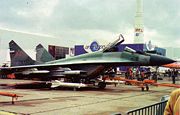
- MiG-29M / MiG-33 (Product 9.15)
- Advanced multi-role variant, with a redesigned airframe, mechanical flight controls replaced by a fly-by-wire system and powered by enhanced RD-33 ser.3M engines. NATO reporting code is Fulcrum-D.
- MiG-29UBM (Product 9.61)
- Two-seat training variant of the MiG-29M. Never built.
- MiG-29SMT (Product 9.17)
- In 1998 a decision was made by the Defense Ministry to launch a quantity-modernization program of the MiG-29 fighters. A total of 150 to 180 modernized MiG-29SMTs was be introduced in service with the Russian Air Force. Extensive modernization was planned only for the aircraft produced through the previous decade. The modernization program started in September 1998 by the Kubinka military aircraft-repair plant and the MAPO MIG. The first batch of 10 to 15 MiG-29SMTs was delivered before the end of the year. In 1999, a total of 20 to 30 MiG-29 fighters were modernized into the MiG-29SMT version, approaching fifth-generation fighters in terms of characteristics. Starting from the year 2000, the program's annual modernization rate was expected to reach 40 MiG-29SMTs. The overall plan provides for modernization of 150-180 MiG-29s to the MiG-29SMT status and 120 more to the MiG-29UBT (2 seater) status, with the remainder of the older aircraft withdrawn from service.
The MiG-29SMT fighter displays a number of essentially new capabilities to effectively destroy both air and ground (sea surface) targets with the use of high-precision “air-to-air” and “air-to-surface” missiles, thus combining the roles of air superiority fighter and strike fighter.
The MiG-29SMT is the up-to-date modification of MiG-29 multirole frontline fighter. The aircraft exhibits a long flight range due to extra capacity of integral fuel tanks and installation of in-flight refueling system (similar to that of the MiG-29SD). The aircraft and engine service life and time limits and design service life have been feasibly increased; the labor requirements and maintenance costs have been reduced.
The MiG-29 evolution program initiated in the late 80-s led to the creation of the aircraft distinguished from the basic version not only by noticeable improvement of the fighter main parameters as a weapons platform-carrier (longer operational range), but also by principally new features.
The most vital feature of this fighter is the capability to effectively operate against air and ground or sea surface targets with the use of high-precision air-to-surface missiles, thus making it a multirole combat aircraft incorporating in one air vehicle the qualities of air superiority fighter and tactical strike aircraft.
The weapon control system of the MiG-29SMT aircraft is built around the ZHUK-ME advanced multimode radar developed by the PHASOTRON-NIIR Moscow-based company. The integrated system incorporates a digital top-level computer system based on the principles of open architecture with use of multiplex data buses, meeting the MIL-STD-1553B requirements. This system makes the MiG-29SMT compatible with an exceptionally wide range of smart weapons. The cockpit of the aircraft was also drastically redesigned. It features two large-format color liquid-crystal displays (LCD's) measuring 152 x 203 mm (6 x 8 inch) in the front of the cockpit and two more LCDs on the side consoles for control over weapons systems, navigation, ECM, communications and information-control system. The displays are developed by the Ramenskoye instruments design bureau (city of Ramenskoye, Moscow region).
Another important development in the MiG-29SMT design are two new radars. One radar is designed to operate in millimetric-wave band and the other one in the centimetric-wave band. Both of the radars are multi-mode and one of them can be used in the side-looking mode for special purposes.
The Hand-on-throttle and stick (HOTAS) concept is fully realized in the MiG-29SMT cockpit; the pilot controls the aircraft, performs targeting and launches weapons without removal of hands from the control stick and throttle control lever.
The MiG-29SMT aircraft six underwing and one ventral store stations can carry up to 5000 kg of external load, including the R-73E agile air-to-air missiles with a combined gas-aerodynamic control system and IR seeker with a wide off-boresight angles range, the RVV-AE medium-range air-to-air missiles with an active radar seeker and the R-27R1/ER1 medium-range air-to-air missiles with a semi-active radar seeker.
In operation against ground and sea surface targets, the MiG-29SMT is able to effectively use contemporary high-precision weapons: the Kh-29T(TE) air-to-surface missiles with a TV seeker, the Kh-31A antiship missiles, the Kh-31P antiradar missiles, the KAB-500KR guided bombs with a TV seeker and powerful warhead.
The upgraded model of batch production MIG-29SMT fighter has an additional two tanks of propellant can cover, without refueling, up to 3,500 kilometers and carry up to 5 tonnes of combat payload. The hatch design compares favorably with that of the predecessor models. The upgraded MIG can be committed to action as a fighter, interceptor, attack, reconnaissance or command post plane. It can, as a command post plane, be acting in contact with A-50 long-range radio detection and control jets. Any kind of Russian- or foreign-made air-to-air and air-to-surface launchers may be mounted aboard this plane.
A new up-to-date cockpit data display and control field, open-architecture airborne equipment complex based on highly effective computing facilities and multiplex communication channels (new navigation, ECM, communication, guidance and data recording systems) can be integrated. The aircraft can be provided with the "Zhuk-M" multimode radar boosting a longer range of air target detection and +/-90° viewing angle in azimuth. The radar is able to track a greater number of targets and engage them simultaneously; scanning in the air-to-surface modes (including those of high resolution) based on indication of moving and sea-surface targets have been incorporated. The weapons mix is widened.
At the buyer's request, radar-absorbent coatings can be applied, Western and national equipment can be installed and number of store stations can be increased. The process of in-service aircraft upgrading up to the MiG-29SMT level has been developed. Works on the aircraft further upgrading are under way.
MiG Corp. has also developed a modular system of MiG-29 upgrading to the MiG 29SMT level. This system is flexible, allowing potential clients to chose the set of aircraft upgrades what they really need. Set of upgrades includes three modules. First module is upgrading the aircraft weapons control system transforming MiG-29 into multirole fighter. A new “Zhuk-ME” radar with a terrain mapping mode is installed. Upgrade of the weapons control system allow to increase considerably the range of “air-to-air” and “air-to-ground” guided and unguided weapons.
While keeping unbeatable air combat characteristics, MiG-29 obtains strike functions, comparable with modern foreign competitors. Second module is increasing internal and drop fuel tanks capacity, upgrading fuel system and installing in-flight refueling equipment, adopted, according to customer’s demand, for usage with Russian or foreign tanker aircraft. Third module is upgrading of on-board equipment and installation digital fly-by-wire control system. Pilot’s cockpit is equipped with color LCD MFDs, modern flight navigation and communication equipment including satellite navigation of Russian or foreign origin, fully compliant with NATO and ICAO standards.
In case of MiG-29 complete upgrading to MiG-29SMT level the customer receives a generation “4+” level aircraft, close in characteristics and by set of equipment to the newest MiG-29M. It is equal, even superior in some positions, to modern foreign competitors, able to keep, prior to proper exploitation and maintenance, its combat effectiveness for the next 20 years. And MiG Corp. can make all upgrades on the territory of customer and on its manufacturing facilities.
The MiG-29SMT aircraft features:
· Longer range and flight endurance; · High combat effectiveness; · Superb agility; · High reliability and flight safety; · Easy operation and reduced DOC, up-to-date logistic support; · Advanced architecture of cockpit avionics and information control system, HOTAS; · Integrated fire-control system consisting of upgraded radar fire-control system built around the ZHUK-ME advanced multimode radar boasting longer operating ranges, multichannel firing and up-to-date air-to-surface modes, and of improved IR search and track system and helmet-mounted sight; · Up-to-date navigation, radio communication, electronic countermeasures, monitoring and recording systems as well as optronic and reconnaissance pods; · Modified weapon system including the RVV-AE, R-27ER1, R-27ET1, R-27R1, R-27T1, R-73E air-to-air missiles, the Kh-31A, Kh-31P, Kh-29T (TE), Kh-29L air-to-surface missiles, the KAB-500KR (OD), KAB-500L guided bombs, rockets, free-fall bombs and the GSh-301 built-in gun.
- MiG-29UBT (Product 9.51T)
- SMT Standard upgrade for the MiG-29UB. Namely users, Algeria and Yemen.[36][37]
- MiG-29M2 / MiG-29MRCA
- Two-seat version of MiG-29M (possibly based on the cancelled MiG-29UBM). Identical characteristics to MiG-29M, with a slightly lesser operational range of 1800km. RAC MiG presented in various air shows, to name a few, Fifth China International Aviation and Aerospace Exhibition (CIAAE 2004),[38] AERO INDIA 2005,[39][40] MAKS 2005.[41]. It was once given designation MiG-29MRCA for marketing purpose and now evolved into the current MiG-35.
- MiG-29OVT
- The aircraft is one of the six pre-built MiG-29Ms before 1991, later received thrust-vectoring engine and fly-by-wire technology. It served as a thrust-vectoring engine testbed and technology demonstrator in various air shows to show future improvement in the MiG-29M. It has identical avionics to the MiG-29M. The only difference in the cockpit layout is an additional switch to turn on vector thrust function. The two RD-133 thrust-vectoring engines, each features unique rotating nozzles which can provide thrust vector deflection in all directions. However, despite its thrust-vectoring, other specifications were not officially emphasized. The aircraft is being demonstrated along with the MiG-29M2 in various air shows around the world for potential export. The aircraft is usually used as an aerobatic demonstrator.[42]
- MiG-35
- A recently unveiled mass upgraded MiG-29M2. NATO reporting code is Fulcrum-F.

- MiG-29G/MiG-29GT
- It was a upgrade standard for the German Luftwaffe's MiG-29 / 29UB, inherited from the former East Germany to the NATO standards. Works was done by MiG Aircraft Product Support GmbH (MAPS), a joint venture company form between MiG Moscow Aviation Production Association and DaimlerChrysler Aerospace in 1993.[43]
- MiG-29AS/MiG-29UBS (MiG-29SD)
- Slovak Air Force performed an upgrade on their MiG-29/-29UB for NATO compatibility. Work is done by RAC MiG and Western firms, starting from 2005. The aircraft now has navigation and communications systems from Rockwell Collins, an IFF system from BAE Systems, new glass cockpit features multi-function LCD displays and digital processors and also fitted to be integrate with Western equipment in the future. However, the armaments of the aircraft remain unchanged. 12 out of 21 of the entire MiG-29 fleet were upgraded and had been delivered as of late February, 2008.[44]
- MiG-29 Sniper
- attempt of upgrade Romanian Air Force MiG-29s, by Israeli firms. The program was halted along with the retiring of Romanian MiG-29s in 2003. The latter occurred because of high maintenance costs, which led to the Romanian Government's decision to halt the MiG-29 program and further invest in the MiG-21 LanceR program.
Operators






Current
 Armenia
Armenia Algeria
Algeria Azerbaijan
Azerbaijan Bangladesh
Bangladesh Belarus
Belarus Bulgaria
Bulgaria Cuba
Cuba Eritrea
Eritrea Hungary To be phased out in 2010.
Hungary To be phased out in 2010. India
India Iran
Iran Kazakhstan
Kazakhstan Malaysia
Malaysia Myanmar order next 15 and (some may be Su-27) in 2009
Myanmar order next 15 and (some may be Su-27) in 2009 North Korea 30 in service
North Korea 30 in service Peru
Peru Poland
Poland Russia
Russia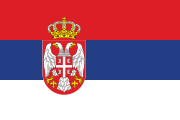 Serbia
Serbia Slovakia
Slovakia Sudan
Sudan Syria
Syria Turkmenistan
Turkmenistan Ukraine
Ukraine United States As aggressor unit.
United States As aggressor unit. Uzbekistan
Uzbekistan Yemen
Yemen Sri Lanka
Sri Lanka
Former
 Czechoslovakia/
Czechoslovakia/ Czech Republic
Czech Republic East Germany/
East Germany/ Germany
Germany Iraq
Iraq Moldova Not operational.
Moldova Not operational. Romania
Romania Soviet Union
Soviet Union Yugoslavia/
Yugoslavia/ Yugoslavia
Yugoslavia
Possible operators
 Egypt (planning to acquire the MiG-29SMT)
Egypt (planning to acquire the MiG-29SMT)
MiG-29s on display
There are several museums in Russia that display MiG-29s:
- Three are stationed in Central Air Force Museum in Monino near Moscow. One is a prototype, one an early production model (both with ventral fins), and one a MiG-29KVP
- One MiG-29 (9-13) is on display of the Museum of the Great Patriotic War, Moscow on the Poklonnaya Hill
- Another MiG-29 can be found at the Central Armed Forces Museum in Moscow
One MiG-29 is on display at the Muzeum Wojska Polskiego in Warsaw, Poland.
One MiG-29 is on display in Germany. The only remaining German MiG-29G (29+03) was transferred from Laage to the Luftwaffenmuseum der Bundeswehr in Berlin's Gatow Airport, being part of the exhibition "50 Jahre Luftwaffe".[45]
- No. 67 (MiG-29 Sniper proto) is on display at the Romania Muzeul Aviatiei, Bucharest.
Six former Moldova Air Force MiG-29s are currently on display in the United States at the following locations:
- Goodfellow AFB in Texas[5]
- NAS Fallon Airpark in Nevada
- Two MiG-29s are on display at Nellis AFB in Nevada. One is at the outside of the Threat Training facility and another, in better shape, inside a hangar alongside a MiG-23.[6]
- For several years an early MiG 29A (s/n 2960516761) was stored in a restoration hangar at the National Museum of the United States Air Force near Dayton, Ohio. In June 2007 the aircraft was put on display in the Cold War Gallery of the Museum and continues to receive minor upgrading while on display. It was formerly assigned to the 234th Gvardeiskii Istrebitelnii Aviatsionnii Polk (234th Guards Fighter Aviation Regiment) stationed at Kubinka Air Base near Moscow. This aircraft was one of six MiG-29s that made a good will visit to Kuoppio-Rissala, Finland, in July 1986, an event that marked the first public display of the MiG-29. http://www.nationalmuseum.af.mil/shared/media/photodb/photos/070313-F-1234P-038.jpg][7]
- A MiG-29 is on display outside of the Evergreen Aviation Museum in McMinnville, Oregon.
- The second MiG-29UB prototype (9-52) is on display at the Riga Aviation Museum. After 213 test flights around Moscow between 23 August 1982 and 10 April 1986, it was disassembeled and parts of the wings and tails were re-used in prototype (9-16). The remains were shipped to Riga Military Aviation Engineers High School, and later handed over to the Riga Aviation Museum in 1994, where it is currently displayed. The remains of this prototype is in a very bad condition, with open fuselage panels and a partly broken canopy and open cockpit that exposes the airframe to inclement weather.
Specifications
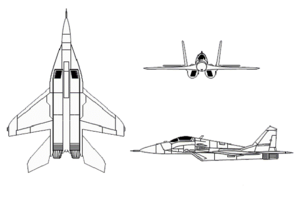
General characteristics
- Crew: One
- Length: 17.37 m (57 ft)
- Wingspan: 11.4 m (37 ft 3 in)
- Height: 4.73 m (15 ft 6 in)
- Wing area: 38 m² (409 ft²)
- Empty weight: 11,000 kg (24,250 lb)
- Loaded weight: 16,800 kg (37,000 lb)
- Max takeoff weight: 21,000 kg (46,300 lb)
- Powerplant: 2× Klimov RD-33 afterburning turbofans, 8,300 kgf (approximate 81.4 kN) each
Performance
- Maximum speed: Mach 2.4 (2,445 km/h, 1,518 mph)
- Range: 700 km combat, 2,900 km ferry (430 mi / 1,800 mi)
- Service ceiling 18,013 m (59,100 ft)
- Rate of climb: initial 330 m/s average 109 m/s 0-6000 m [46] (65,000 ft/min)
- Wing loading: 442 kg/m² (90.5 lb/ft²)
- Thrust/weight: 1.13
Armament
- 1x 30 mm GSh-30-1 cannon with 100 rounds
- Up to 3,500 kg (7,720 lb) of weapons including six air-to-air missiles — a mix of semi-active radar homing (SARH) and AA-8 "Aphid", AA-10 "Alamo", AA-11 "Archer", AA-12 "Adder", FAB 500-M62, FAB-1000, TN-100, ECM Pods, S-24, AS-12, AS-14.
Avionics
- Phazotron N019, N010 radars
See also
- 4th generation jet fighter
Related development
- Mikoyan MiG-29M
- Mikoyan MiG-35
Comparable aircraft
- F/A-18 Hornet
- F-16 Fighting Falcon
- Dassault Mirage 2000
- HAL Tejas
- J-10
Related lists
- List of military aircraft of the Soviet Union and the CIS
- List of fighter aircraft
References
Notes
- ↑ 1.0 1.1 Zuyev, A.; McConnell, M.. Fulcrum: A Top Gun Pilot’s Escape From the Soviet Empire. Warner Books, 1993. ISBN 0-446-36498-3.
- ↑ Lake 1987, p. 94.
- ↑ "The Paris Air Show Twenty Years On". Weekly Standard.
- ↑ RIA Novosti. Russia suspends MiG-29 fighter flights over Siberia crash. 17 October, 2008.
- ↑ "USA Air Force Milestones" (31 December 1999).
- ↑ "Cuba". UMN.
- ↑ "Eritrean Fulcrums".
- ↑ "Russia ‘shot down Georgia drone’". BBC.
- ↑ "Georgia". International Herald Tribune (2008-05-26).
- ↑ Strtegy
- ↑ [1]Sudan
- ↑ "MiG-29 Baaz".
- ↑ "News". Klimov (2007-01-24).
- ↑ "Report". India Defence.
- ↑ Times of India
- ↑ "Strategy" (2005-05-20).
- ↑ 17.0 17.1 ACIG 380
- ↑ [2]
- ↑ [3]
- ↑ [4]
- ↑ Serbian Armed Forces
- ↑ MiG-29 photograph
- ↑ FAS MiG-29
- ↑ Buzzards, AeroWeb.
- ↑ Code One, 1995-07.
- ↑ Lake 1997, p. 70.
- ↑ MiGi za 1 euro w Bydgoszczy (Polish).
- ↑ "Bilder". Fabulous Fulcrums.
- ↑ Bundeswehr
- ↑ "Transcript". Defense Link.
- ↑ Hoffman, Carl. "Building Your Own Air Force, One Mig at a Time." Wired magazine, issue 13.10.
- ↑ 32.0 32.1 Rac Mig
- ↑ India Daily
- ↑ Rac MiG News
- ↑ en.rian.ru Fulcrim
- ↑ Centre for Analysis of Strategies and Technologies - CAST comments
- ↑ Moscow Defense Brief
- ↑ People's Daily Online - Latest MiG-29 planes to be flown
- ↑ Rac Mig
- ↑ ACIG Exclusives: Aero India 2005: Chapter 4
- ↑ MAKS 2005 highlights
- ↑ Aviapedia » Mig-29VFT video from “Smotr” tv-series
- ↑ Moscow Defense Brief
- ↑ Russian MiG-29
- ↑ German MiG-29
- ↑ FLUG REVUE Datafiles: Mikojan MiG-29
Bibliography
- Lake, Jon. Jane's How to Fly and Fight in the Mikoyan MiG-29. New York: HarperCollins, 1997. ISBN 0-00472144-6.
External links
- RAC MiG official site
- German Luftwaffe's former MiG-29 Staffel 1./JG 73"Steinhoff" in Laage
- MiG-29 "Fulcrum" page by GlobalSecurity.org
- MiG-29 "Fulcrum" page by the Federation of American Scientists
- Cuban MiG-29
- India buys cutting-edge Russian warplanes MiG-29KUB
- US purchases MiG-29 fighters from Moldova
|
|||||||||||||||||
|
||||||||||||||
